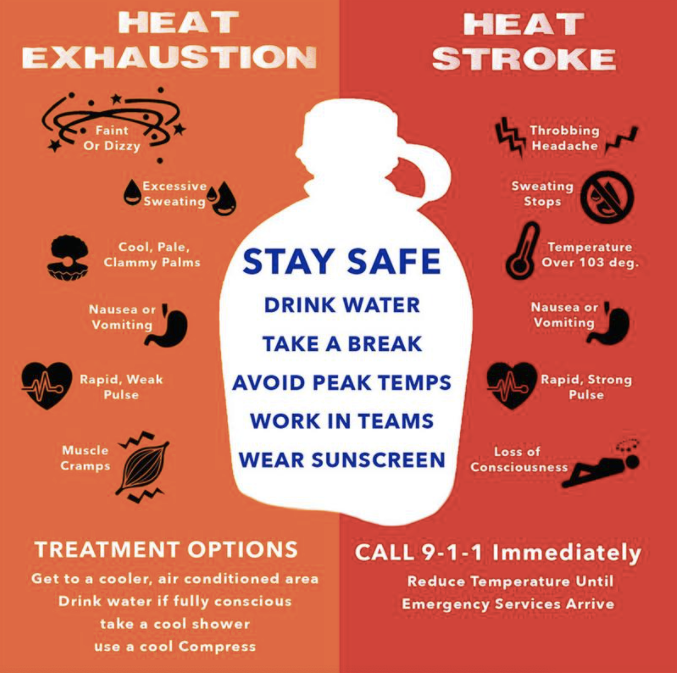Preventing Heat Injury During the Summer
go.ncsu.edu/readext?810102
en Español / em Português
El inglés es el idioma de control de esta página. En la medida en que haya algún conflicto entre la traducción al inglés y la traducción, el inglés prevalece.
Al hacer clic en el enlace de traducción se activa un servicio de traducción gratuito para convertir la página al español. Al igual que con cualquier traducción por Internet, la conversión no es sensible al contexto y puede que no traduzca el texto en su significado original. NC State Extension no garantiza la exactitud del texto traducido. Por favor, tenga en cuenta que algunas aplicaciones y/o servicios pueden no funcionar como se espera cuando se traducen.
Português
Inglês é o idioma de controle desta página. Na medida que haja algum conflito entre o texto original em Inglês e a tradução, o Inglês prevalece.
Ao clicar no link de tradução, um serviço gratuito de tradução será ativado para converter a página para o Português. Como em qualquer tradução pela internet, a conversão não é sensivel ao contexto e pode não ocorrer a tradução para o significado orginal. O serviço de Extensão da Carolina do Norte (NC State Extension) não garante a exatidão do texto traduzido. Por favor, observe que algumas funções ou serviços podem não funcionar como esperado após a tradução.
English
English is the controlling language of this page. To the extent there is any conflict between the English text and the translation, English controls.
Clicking on the translation link activates a free translation service to convert the page to Spanish. As with any Internet translation, the conversion is not context-sensitive and may not translate the text to its original meaning. NC State Extension does not guarantee the accuracy of the translated text. Please note that some applications and/or services may not function as expected when translated.
Collapse ▲As hot as it has been lately and will continue for the next month or two, it’s never too late to review ways to protect yourself from heat exhaustion and heat stroke. To help with this, the following information has been supplied by the US Department of Labor Occupational Safety and Health Administration (OSHA):
When the body is unable to cool itself through sweating, serious heat illnesses may occur. The most severe heat induced illnesses are heat exhaustion and heat stroke. If left untreated, heat exhaustion could progress into heat stroke and possible death. When temperatures exceed 85 degrees and 30% humidity, we should be cautious; but once they exceed 95 degrees and 60% humidity, the danger escalates.
Symptoms of heat exhaustion include headaches, dizziness or lightheadedness, weakness, mood changes such as irritability, confusion or the inability to think straight, upset stomach, vomiting, decreased or dark colored urine, fainting or passing out, and pale, clammy skin. To minimize and prevent heat exhaustion, the following steps should be taken:
- Act immediately. If not treated, heat exhaustion may advance to heat stroke or death.
- Move the victim to a cool, shaded area to rest. Don’t leave the person alone. If symptoms include nausea or upset stomach, lay the victim on his or her side.
- Loosen and remove any heavy clothing.
- Have the person drink cool water (about a cup every fifteen minutes) unless sick to the stomach.
- Cool the person’s body by fanning and spraying with a cool mist of water or applying a wet cloth to the person’s skin.
- Call 911 for emergency help if the person does not feel better in a few minutes.
Heat Stroke includes the same symptoms as heat exhaustion, but may also include dry, pale skin with no sweating, hot red skin that looks sunburned, seizures or fits, and unconsciousness with no response.
In addition to the above steps for heat exhaustion, during heat stroke you should also:
- Lay the victim on his or her back in a cool, shaded area and move any nearby objects away from the person if symptoms include seizures or fits. If symptoms include nausea or upset stomach, lay the victim on his or her side.
- Cool the person’s body by fanning and spraying with a cool mist of water or wiping the victim with a wet sheet.
- Place ice packs under the armpits and groin area.
Anyone who works in the heat should protect themselves and coworkers through the following tips:
- Learn the signs and symptoms of heat-induced illnesses and how to respond.
- Perform the heaviest work during the coolest part of the day.
- Build up tolerance to the heat and the work activity slowly (usually over two weeks)
- Use the buddy system, with people working in pairs.
- Drink plenty of cool water, about a cup every 15-20 minutes.
- Wear light, loose-fitting, breathable clothing, such as cotton.
- Take frequent, short breaks in cool, shaded areas to allow the body to cool down.
- Avoid eating large meals before working in hot environments.
- Avoid alcohol or beverages with caffeine. These make the body lose water and increase the risk for heat illnesses.
There are other factors that may put you at risk for heat injury. These may include wearing personal protective equipment such as a respirator or protective suit that will retain heat, having a previous heat-induced illness, and taking certain medications. When on medications, check with your healthcare provider to see if any medicines you are taking affect you when working in hot environments.
Hopefully these tips will serve as a reminder to us all to slow down and cool off as we get through the remaining weeks of summer. Stay cool and hydrated every chance you get!




